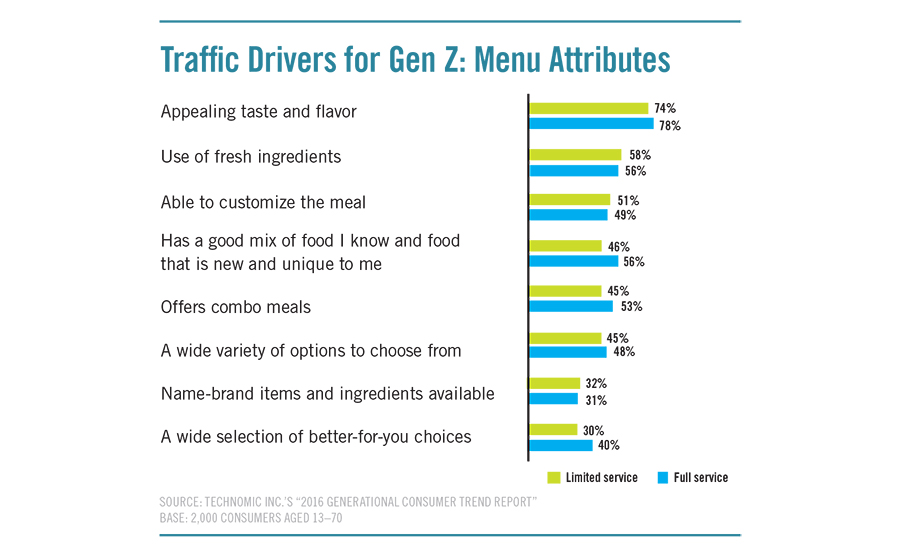Many major brands have been clamoring in recent years to uncover what drives Millennials to foodservice. Now it’s time for operators to focus on the next generation of young consumers—Generation Z, a group that is coming of age and looking for foodservice that satisfies its food cravings.
Members of Gen Z prioritize food and beverage, which account for 23% of their spending (followed by clothing, at 20%). Technomic’s “2016 Generational Consumer Trend Report” introduces foodservice providers to this diverse group of teens, college students and young professionals, identifying behaviors and needs of Gen Z to aid in capturing their foodservice occasions.
Generation Z ranges in age from 13-23 and makes up 20% of the US population. As the most ethnically diverse generation in the nation’s history—with just 53% classified as non-Hispanic white—Gen Z searches for foods and beverages just as unique and diverse.
Adding ethnic spices, sauces and other ingredients into dishes also will attract this group in search of new and unfamiliar flavors. Noodles & Company recently launched Spicy Korean Beef Noodles, which has steak in a gochujang sauce with Napa and red cabbages, Asian sprouts and spinach on ramen, topped with cucumber, green onions and cilantro. Tropical Smoothie Cafe added Thai Chicken to its menu for a limited time. It’s featured in a wrap or salad with cilantro, carrots, wontons, sesame seeds and Thai peanut sauce. A spicy version of the wrap and salad has sriracha aioli and Thai chili sauce.
Compared with other generations, the diverse Gen Z group is more driven to foodservice by new and unique offerings: 23% of Gen Z-ers actively seeks out unique flavors, vs. 17% of all other generations. Chains’ incorporation of existing brands, such as Cheetos, into menu items is a way to offer Gen Z something unique and craveable. Burger King has rolled out Mac n’ Cheetos snacks at select units, and Taco Bell is currently testing the Cheetos Burrito with rice, seasoned ground beef, nacho cheese sauce and Cheetos in a flour tortilla.
Mashups and daypart crossovers also offer a way to differentiate. IHOP recently introduced Criss-Croissants: waffle-cooked croissant dough with fillings and toppings. The hybrid dish, being promoted as an “anytime” meal, is available in three varieties: Salted Caramel & Banana, Strawberries & Sweet Cream Cheese and Spinach & Roasted Red Pepper. Additionally, this summer, Firebirds Wood Fired Grill added a burger for breakfast, lunch or dinner; the limited-time Southern Biscuit Burger has a hamburger patty topped with ham, Tillamook Cheddar and chipotle gravy on a biscuit.
Taste and craveability are crucial to enticing Gen Z consumers, even at the expense of nutrition, freshness and quality. Current data show that health considerations aren’t factored into foodservice decisions of Gen Z consumers, although this is likely to change as they age.
While their spending power is a fraction of older generations, members of Gen Z have been able to make independent purchasing decisions since a young age, with the help of technology. Currently, Gen Z sources about 30% of meals and snacks from foodservice. But, as the spending power of this generation grows, so will its impact on restaurants and foodservice providers. Getting to know Gen Z’s preferences will be increasingly important to attract new consumers who are just beginning to explore their options—and to hopefully encourage repeat business with unique, craveable items.
Originally appeared in the October, 2016 issue of Prepared Foods as Influence of Gen Z Grows.
